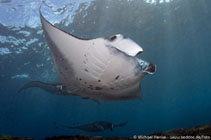http://www.fishbase.org/Summary/speciesSummary.php?genusname=Manta&speciesname=alfredi ---> http://52.67.158.155/Summary/speciesSummary.php?genusname=Manta&speciesname=alfredi
http://52.67.158.155/Summary/speciesSummary.php?genusname=Manta&speciesname=alfredi ---> https://fishbase.net.br/Summary/speciesSummary.php?genusname=Manta&speciesname=alfredi
https://fishbase.net.br/Summary/speciesSummary.php?genusname=Manta&speciesname=alfredi ---> https://fishbase.net.br/summary/Manta-alfredi.html
Mobula alfredi, Alfred manta

You can
sponsor
this page
Common name (e.g. trout)
Genus + Species (e.g. Gadus morhua)
-

-
About this page
-
Languages
-
User feedbacks
-
Citation
-
Uploads
-
Related species
-


 Alfred manta
Add your observation in
Fish Watcher
Upload your
photos
and
videos
Alfred manta
Add your observation in
Fish Watcher
Upload your
photos
and
videos
Pictures
|
Videos |
Stamps, Coins Misc.
|
Google image
 Mobula alfredi
Mobula alfredi
Picture by
Henke, M.
Elasmobranchii (sharks and rays) >
Myliobatiformes
(Stingrays) >
Mobulidae
(Devilrays)
Etymology:
Environment: milieu / climate zone / depth range / distribution range
Ecology
Marine; benthopelagic; depth range 1 - 120 m (Ref.
86942
). Tropical; 32°N - 34°S, 30°E - 134°W
Indo-West Pacific: Red Sea, South Africa, Thailand to Western Australia.; north to Japan (Yaeyama Is.), to Solitary Is., Australia as far east as French Polynesia and the Hawaiian Is. Reported in the Atlantic (Canary and Cape Verde islands) but this species may be restricted more or less to the Indian and Western Pacific only (McEachran, pers.comm. 03/10).
Length at first maturity / Size / Weight / Age
Maturity: L
m
371.1
, range 324 - 390 cm
Max length : 500 cm WD male/unsexed; (Ref.
82755
); max. reported age: 31 years (Ref.
97313
)
Short description
Morphology
|
Morphometrics
This species is characterized by the following: disc approximately 2.2-2.4 times as broad as it is long, the maximum disc width size approximately 550 cm; slender whip-like tail approximately 123% of disc length if intact; no distinct caudal spine or cartilaginous mass at base of tail; some specimens have small hump at the base of the tail on the dorsal surface, while others have a slight depression and groove on the dorsum of the tail immediately posterior to the posterior margin of the dorsal fin; small, knob-like dermal denticles evenly distributed on both the dorsal and ventral surfaces, with ventral surface having slightly larger denticles; dental ligament with small cusped teeth on the lower jaw measuring roughly 22% of total disc length, approximately 6-8 rows, 142-182 files across entire width of the tooth band; total tooth counts of 900-1500 for entire tooth band; top jaw lacks rows of enlarged denticles (Ref.
82755
).
Adults are commonly sighted inshore, within a few kilometers of land; found around coral and rocky reefs as well as along productive coastlines with consistent upwelling, tropical island groups, atolls and bays (Ref.
82755
). Maximum movement recorded is >500,000 m (Ref.
97317
). Known aggregations include sites in Hawai'i, Mozambique, Maldives, Ryukyu Island, Yap Island, Indonesia, eastern and western Australia (Ref.
82755
). Gestation period is 12-13 months. Major food consists of planktonic organisms and probably small bony fishes (Ref.
114953
).
Young may tend to follow large objects such as their mother (Ref.
205
).
Last, P.R., W.T. White, M.R. de Carvalho, B. Séret, M.F.W. Stehmann and G.J.P. Naylor
, 2016. Rays of the world. CSIRO Publishing, Comstock Publishing Associates. i-ix + 1-790. (Ref.
114953
)
IUCN Red List Status (Ref.
130435
)
Vulnerable (VU)
(A2bcd+3d); Date assessed:
09 November 2018
CITES
Appendix II:
International trade monitored
Appendix I & II:
Endangered migratory species conserved through agreements
Threat to humans
Harmless
Human uses
FAO - Publication:
search
|
FishSource
|
More information
Countries
FAO areas
Ecosystems
Occurrences
Introductions
Stocks
Ecology
Diet
Food items
Food consumption
Ration
Common names
Synonyms
Metabolism
Predators
Ecotoxicology
Reproduction
Maturity
Spawning
Spawning aggregation
Fecundity
Eggs
Egg development
Age/Size
Growth
Length-weight
Length-length
Length-frequencies
Morphometrics
Morphology
Larvae
Larval dynamics
Recruitment
Abundance
BRUVS
References
Aquaculture
Aquaculture profile
Strains
Genetics
Electrophoreses
Heritability
Diseases
Processing
Nutrients
Mass conversion
Collaborators
Pictures
Stamps, Coins Misc.
Sounds
Ciguatera
Speed
Swim. type
Gill area
Otoliths
Brains
Vision
Tools
E-book
|
Field guide
|
Length-frequency wizard
|
Life-history tool
|
Point map
|
Classification Tree
|
Catch-MSY
|
Special reports
Check for Aquarium maintenance
|
Check for Species Fact Sheets
|
Check for Aquaculture Fact Sheets
Download XML
Summary page
|
Point data
|
Common names
|
Photos
Internet sources
AFORO (otoliths) |
Aquatic Commons
|
BHL
|
Cloffa
|
BOLDSystems
|
Websites from users
|
Check FishWatcher
|
CISTI
|
Catalog of Fishes
:
genus
,
species
|
DiscoverLife
|
DORIS
|
ECOTOX
| FAO - Publication:
search
|
Faunafri
|
Fishipedia
|
Fishtrace
| GenBank:
genome
,
nucleotide
|
GloBI
|
Google Books
|
Google Scholar
|
Google
| IGFA World Record |
MitoFish
|
National databases
|
Otolith Atlas of Taiwan Fishes
|
PubMed
| Reef Life Survey | Socotra Atlas |
Tree of Life
| Wikipedia:
Go
,
Search
| World Records Freshwater Fishing |
Zoological Record
Estimates based on models
Preferred temperature (Ref.
123201
): 24.3 - 29, mean 27.8 °C (based on 1274 cells).
Phylogenetic diversity index (Ref.
82804
): PD
50
= 0.5005 [Uniqueness, from 0.5 = low to 2.0 = high].
Bayesian length-weight: a=0.01000 (0.00244 - 0.04107), b=3.04 (2.81 - 3.27), in cm total length, based on all LWR estimates for this body shape (Ref.
93245
).
Trophic level (Ref.
69278
): 3.5 ±0.5 se; based on size and trophs of closest relatives
Resilience (Ref.
120179
): Very Low, minimum population doubling time more than 14 years (tmax>31; tm = 3-8; Fec =1).
Fishing Vulnerability (Ref.
59153
): Very high vulnerability (85 of 100).
Nutrients (Ref.
124155
): Calcium = 5.54 [0.80, 100.50] mg/100g; Iron = 0.474 [0.044, 5.786] mg/100g; Protein = 19.2 [13.9, 24.5] %; Omega3 = 0.0832 [, ] g/100g; Selenium = 90.7 [16.3, 541.7] μg/100g; VitaminA = 6.64 [0.42, 83.54] μg/100g; Zinc = 0.545 [0.030, 6.451] mg/100g (wet weight);
Back to Search
Random Species
Back to Top
Accessed through:
Not available
FishBase mirror site :
Laguna, Philippines
Page last modified by :
mrius-barile
|